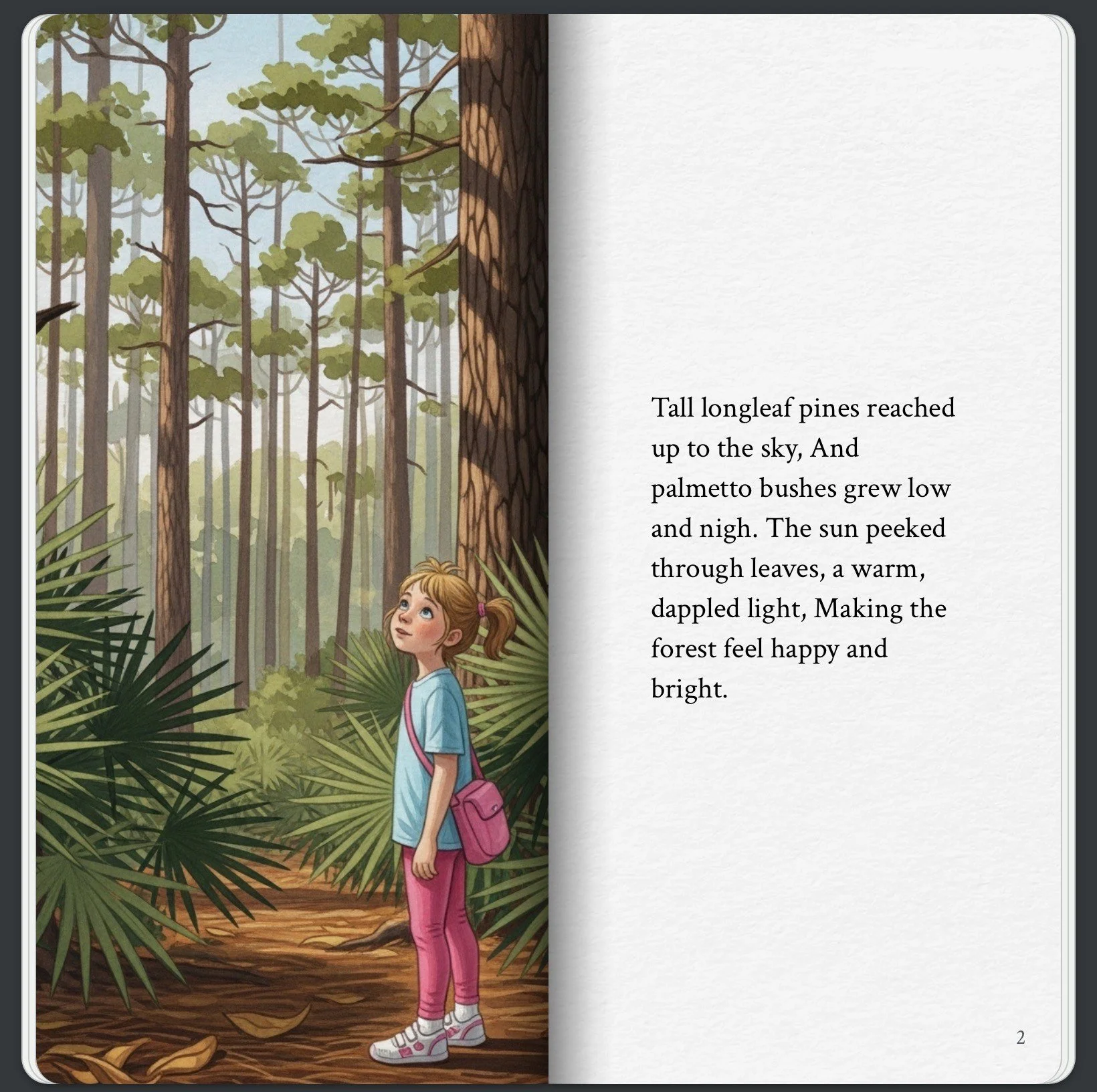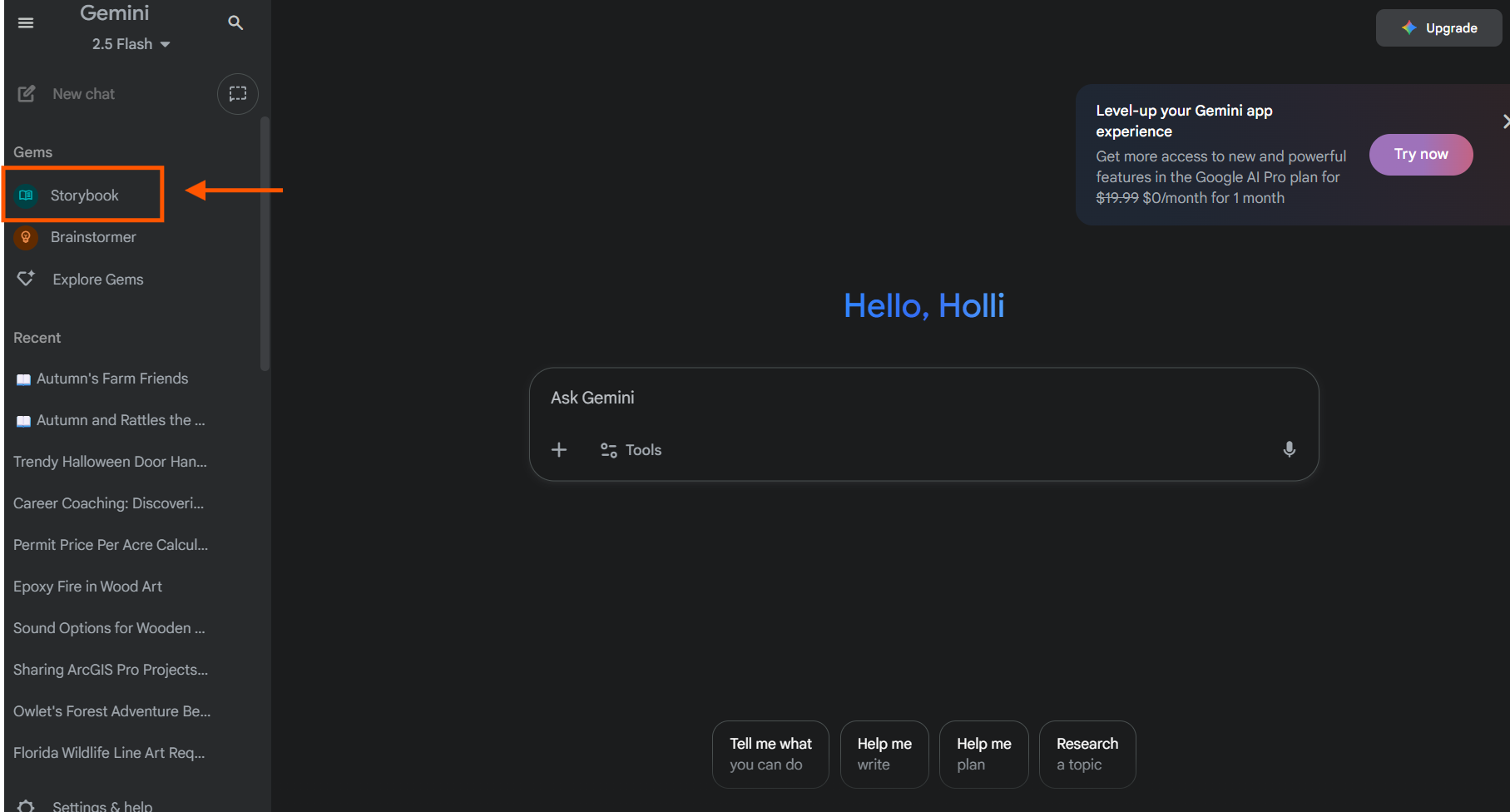Using Google’s Gemini Storybook for Nature Adventures with my Toddler
As a mom, I’m always looking for new and creative ways to spark my toddler’s imagination. Lately, one of my favorite tools for storytelling has been Google’s new Gemini Storybook feature. It allows you to create illustrated, personalized stories simply by typing a prompt and for me, that’s opened up a whole new way of connecting with my daughter.
Instead of just reading books where the main character is someone else’s child or an animal, we can now make her the hero of her own nature adventures. And you know what? She loves it! When she sees herself walking under tall longleaf pines or discovering a barred owl in the trees, she lights up in a way that’s different from when we read store-bought books.
In this post, I want to share:
Why I love using Gemini Storybook to make my toddler the main character.
How I use it to create nature-based stories inspired by our Florida surroundings.
Prompt examples you can try.
Tips for making your stories feel personal, realistic, and magical.
Why Make Your Child the Main Character?
There’s something powerful about a child seeing themselves in a story. It’s not just fun; it’s developmental:
Confidence Boost – When my toddler hears her name in the story, she feels proud and included. It’s like the storyworld belongs to her.
Connection to Nature – By placing her in real habitats (Florida forests, wetlands, backyards), she begins to connect stories to the world outside our door.
Emotional Bonding – It’s a special way to say, “I see you, I value your curiosity, and your adventures matter.”
Learning Made Personal – When she’s the one spotting a red cardinal or splashing in a stream, she remembers those details better.
It turns storytelling into a mirror, not just a window — helping her feel seen, celebrated, and curious about the natural world.
Why Nature Stories?
We live in a fast-paced, screen-filled world, and I want my daughter to grow up feeling grounded in the outdoors. By choosing nature as the backdrop for her stories, I’m reinforcing what we see when we’re outside:
Florida Forest Settings – I describe longleaf pine trees, palmettos, and sandy trails, so the illustrations mirror the landscapes we walk in.
Wildlife Encounters – Owls, cardinals, mockingbirds, and even deer can make appearances in her stories, encouraging recognition in real life.
Imagination Meets Reality – When we go outside and she spots a pine cone, she’ll say, “Just like in my story!” That bridge is magical.
How I Use Gemini Storybook
The process is simple, but a few tweaks make it extra powerful for toddler-focused storytelling.
Start with a Clear Prompt
Gemini will give you the best results if you’re specific. Instead of saying:
“Create a story about Autumn exploring the forest.”
I’ll say:
“Create a story about Autumn, a curious toddler with curly hair, exploring a Florida forest with tall longleaf pine trees, palmettos, and sandy trails. She discovers animal friends along the way.”Include Sensory Details
Toddlers learn with their senses. I often ask Gemini to include sights, sounds, and textures:The crunch of pine needles.
The call of a barred owl.
The soft brush of palmetto fronds.
Keep the Story Simple
Short sentences, playful dialogue, and lots of repetition keep her engaged. I’ll often add:
“Write this story in a gentle, rhyming style for a two-year-old.”Use the Images Wisely
Gemini creates illustrations alongside the story. The first few times, the forest backgrounds didn’t look like Florida — more like generic woods. So now I’ve learned to be extra clear:
“Illustrate a Florida pine forest with longleaf pines, palmettos, and sandy soil.”
The difference is amazing! Suddenly the setting feels familiar and real.Adding Your Child’s Photo
One of the most powerful features of Gemini Storybook is that you can upload a photo of your child (if you’re comfortable doing so). Gemini will then recreate their likeness inside the storybook illustrations.
I’ve tried this with my daughter, and the results are magical. Suddenly the character isn’t just a generic toddler in a forest — it’s her, wavy blonde hair and all, walking in the woods interacting with wildlife.
A quick tip:
· Use a clear, front-facing photo.
· Choose an image where your child’s personality shines (a smile, curious expression, etc.).
· Be mindful of your comfort level with sharing images of your child. You can keep the stories private or printed if you prefer.
When I show my daughter these illustrations, she immediately points and says, “That’s me, mama!” It makes the storytelling experience even more personal and engaging. It also makes her ask for more 😊
Prompt Examples You Can Try
Here are some of my favorite prompts that have worked well for creating toddler-centered nature stories. Feel free to swap in your child’s name, favorite animals, or your local ecosystem.
Prompt 1: Exploring the Pines
“Create a short illustrated story, about 10 pages long, for a toddler about [Child’s Name], a curious little explorer, walking through a Florida forest with tall longleaf pine trees and palmettos. Along the trail, [he/she/they] meets a friendly barred owl who says ‘Who cooks for you?’ Write the story in a gentle, rhyming style with simple sentences.”
Prompt 2: Meeting the Woodpecker
“Write a playful toddler story about [Child’s Name] discovering a pileated woodpecker in the forest. The woodpecker is big, red-crested, and makes loud drumming sounds on a pine tree. Make the story interactive, asking questions like ‘Can you tap your hands like the woodpecker?’”
Prompt 3: Backyard Mockingbird
“Tell a short, cheerful story about [Child’s Name] listening to a mockingbird in the backyard. The bird sings many different songs, and [Child’s Name] tries to copy them. Use simple, fun rhymes.”
Prompt 4: Brown Thrasher Surprise
“Write a toddler-friendly story about [Child’s Name] walking down a sandy path where a brown thrasher hops out from the palmettos. The bird sings two times for every phrase. Keep the story light, musical, and fun.”
Tips for Better Results
Use your child’s name — Hearing their own name makes the story magical.
Describe the setting clearly — Include details like “Florida forest,” “longleaf pines,” “palmettos,” or even “a swamp with cypress knees.”
Guide the style — Add instructions like “gentle rhyme,” “simple sentences,” or “for a two-year-old.”
Embrace the art quirks — Sometimes the AI illustrations come out whimsical, but toddlers don’t mind — they actually love it.
Print or Save the Stories — You can export or screenshot the storybooks to read offline, or even print them as keepsakes.
Why My Toddler Loves It
Every night when we read these AI-created storybooks, my daughter gets this wide-eyed look. She’ll point at the page and say, “That’s me!” or “Palmettos like our forest!”
She’s learning not only to recognize herself as capable and adventurous, but also to see nature as a place for play and wonder. For me, that’s the real win: technology becoming a tool to deepen her connection to the natural world, not replace it.
Conclusion
Google’s Gemini Storybook feature is more than a fun experiment — it’s become a tool for nurturing imagination, nature awareness, and family bonding. By making my toddler the star of her own forest adventures, I’m weaving her real world into the stories we tell, encouraging curiosity and confidence along the way.
If you’re a parent looking for a way to combine personalized storytelling with a love of nature, try giving Gemini Storybook a spin. You might be surprised by how much your child lights up when they see themselves exploring a world that looks just like the one outside your front door.



